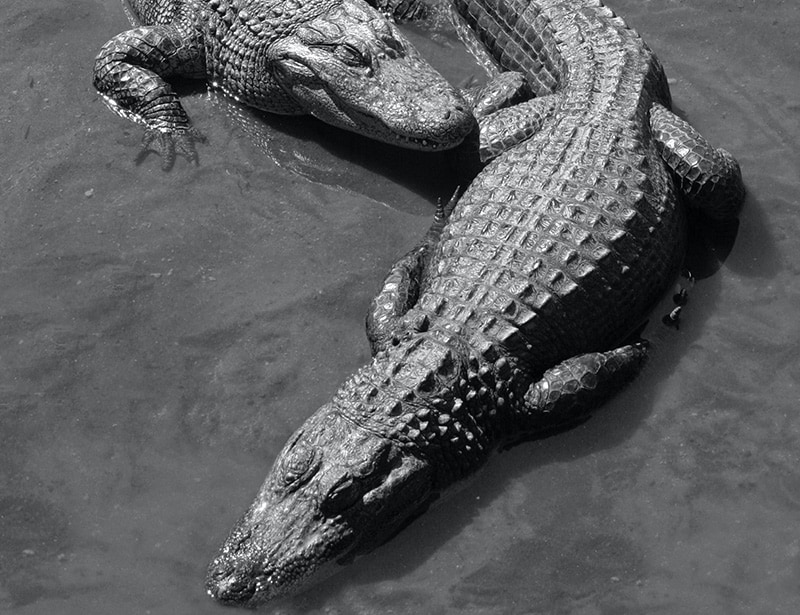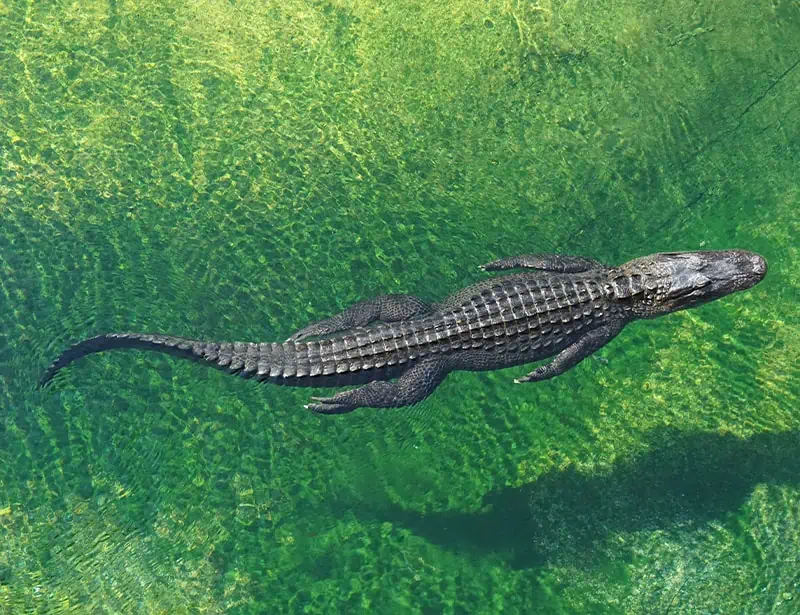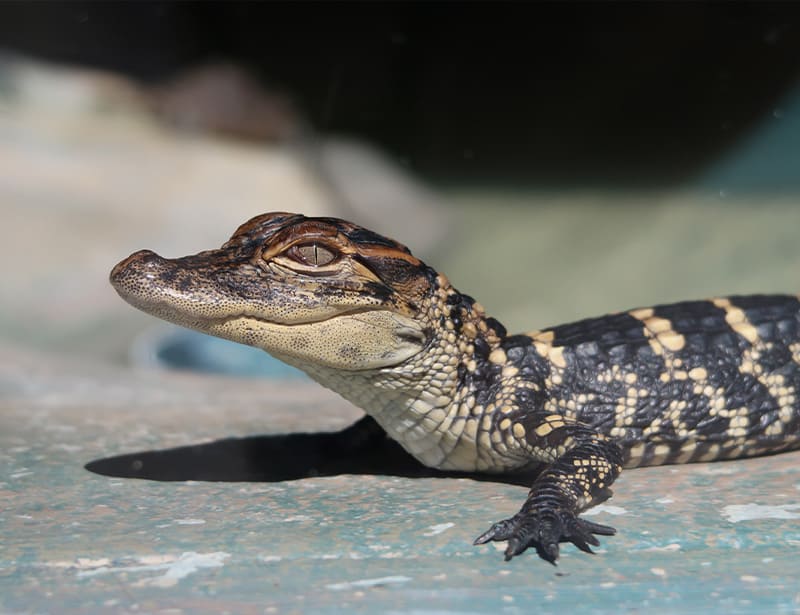15 Alligator Facts To Leave You Chomping for More
Alligators play a crucial role in our planet's ecosystem. In this list of alligator facts, we will examine the characteristics that differentiate them from crocodiles, from their impressive size to their incredible ability to climb trees.
We'll shed light on their biology, behavior, and the significance of conservation efforts to protect these big reptiles. From mating rituals to controllable sex of hatchlings, we've got it covered!
So join us as we explore incredible facts about alligators that will surprise you. Want to learn more about reptiles? Here are some snake facts you might not know and some fun facts about the Komodo Dragon.
15 Alligator Facts You Might Not Know

1. Alligators are living fossils.
The first alligators emerged during the late Cretaceous period. They have descended from the ancient Archosaur group, which lived around 245 million years ago.
After surviving the extinction of the dinosaurs about 65 million years ago, alligators have become “living fossils.” However, paleontologist Julia Molnar stressed that the creatures already underwent drastic evolutionary changes. In a 2015 study, her team investigated the changes in the backbones of alligators’ ancestors and how living in various habitats affected them2.
Even though they give us a glimpse of the past, alligators are specialized animals in their own right. So check the rest of the facts to know why they are one-of-a-kind.
2. Alligators have U-shaped snouts compared to crocodiles.

It’s always tricky to tell alligators and crocodiles apart. However, there are several critical differences you can look for.
First off, pay attention to their snouts. Alligators have a broad, U-shaped snout that looks rounded, built to crush armored prey like turtles and mollusks abounding in their freshwater habitats. On the other hand, crocodiles have a narrower, V-shaped snout, allowing them to snatch and grip various prey, such as fish, birds, and mammals.
They also differ in coloration and habitat preferences. Alligators are generally darker, ranging from black to dark gray, camouflaging in the murky waters of swamps, marshes, and rivers. They prefer fresh water and have specialized glands in their mouths to expel excess salt, although not as efficiently as crocodiles.
3. Alligators have natural body armor.
Alligators have bony plates called osteoderms, or scutes, hidden within their dermis. These rigid structures provide structural support and a natural shield against predators and other threats1.
Furthermore, the alligator's dorsal scales, found on its back, are exceptionally robust and heavily armored with osteoderms. What's impressive is that the arrangement of these bony plates offers flexibility, letting the alligator move quickly while keeping its protective barrier intact.
While alligators may appear ferocious, they have a softer side. The reptile's skin, particularly the belly or ventral scales, is unfortunately highly sought after in the fashion industry.
4. Alligators can grow up to 14 feet long.
Though their sizes vary within the sexes, both females and males are enormous. For example, male American Alligators can reach 14 feet long and weigh over 1,000 pounds. Female alligators are around 8 ft and are generally shorter than males.
This massive size cements their role as apex predators and dramatically influences their social hierarchy. Large male alligators often dominate their smaller counterparts, asserting dominance and maintaining their territory.
On the other hand, adult Chinese Alligators (an alligator species found in China) typically reach lengths of 4.6 to 6.5 feet. Though they are smaller alligators, they are still formidable predators.
5. Alligators also eat fruits.
For many years, people believed alligators to be strictly carnivorous. They are impressive hunters that have quite the appetite. They often lurk near the water’s edge of slow-moving rivers to ambush small fish, birds, and mammals that wander too close. Even other small alligators aren't safe from getting eaten, as these mighty creatures also prey on smaller family members.
However, recent studies have discovered that they are also opportunistic feeders. Surprisingly, they enjoy plant-based foods like fruit, vegetables, seeds, and legumes. Researchers have observed alligators snacking on plant-based treats which offer essential nutrients that might be missing from their primarily meat-based diet3.
6. Alligators are fast and agile swimmers.

Alligators are stealthy swimmers, skillfully combining speed and agility in the water. Their streamlined bodies, powerful tails, and webbed feet allow them to reach impressive speeds of up to 20 mph.
As they dart through the water, alligators use their muscular tails to generate quick, forceful thrusts, swiftly closing in on unsuspecting fish and prey. Remember that these reptilian predators are sprinters. Their bodies allow short bursts of acceleration rather than long swimming sessions.
Moreover, alligators can hold their breath underwater for extended periods, sometimes up to an hour. This skill not only helps them quietly approach their prey but also lets them patiently wait for the perfect moment to strike. While waiting for prey, alligators are entirely submerged, with only their nostrils and eyes peeking above the water's surface, virtually invisible to their target.
7. Alligators are the loudest reptiles with a unique mating process.

The male alligator attracts females during the mating season using deep, powerful bellows and loud grunts. Male alligators draw air into their lungs and expel it, producing these low-frequency vocalizations.
These sounds create vibrations in the water that other alligators can feel and hear. Not only do these calls serve as a mating signal, but they also establish presence and dominance within a territory5. Remarkably, one can hear these bellows up to a mile away, making alligators the loudest reptiles in the world.
Their courtship process isn't limited to these impressive vocalizations, though. Both males and females participate in this acoustic display, letting out roars while mating. These roars play a crucial role in synchronizing reproductive timing among individuals and reinforcing the bond between the mating pair.
Related read: More of the world's loudest animals.
8. Temperature dictates the sex of alligator babies.
Here's an intriguing alligator fact. Did you know that baby alligators' sex, like that of other reptiles, is determined by temperature during egg incubation? The nest's temperature plays a crucial role in determining the sex of the hatchlings through a unique phenomenon known as temperature-dependent sex determination (TSD)4.
Alligator nest temperatures vary during incubation, which usually lasts around 65 days. Warmer temperatures inside the nest, ranging from 32-34°C (89.6-93.2°F), increase the likelihood of males hatching. On the other hand, cooler temperatures below 30°C (86°F) or above 34.5°C (94.1°F) are likely to produce female alligators.
These alligator nests made of vegetation can measure 10 feet in diameter and serve as incubators for about 60 eggs. The mothers also affect the sex ratio of their offspring. For example, choosing nesting areas with abundant sunlight increases the chances of the alligator eggs hatching into males. In contrast, choosing a shady spot can lead to a higher likelihood of female offspring.
9. Alligator mothers care for their young.

Unlike many reptilian species, mothers lay and guard their eggs and actively care for their hatchlings for up to two years, ensuring their safety and well-being during this critical period.
Throughout these formative years, mothers vigilantly protect their eggs from potential predators (which include larger alligators). They also make sure to feed their hatchlings well. Building "nurseries" in shallow waters provides a secure environment for the young alligators to learn essential skills such as hunting and swimming.
In addition, the attentive mother communicates with a baby alligator using a range of vocalizations, such as grunts and hisses. These sounds help maintain group cohesion and enable juvenile alligators to stay close to their mother.
10. Alligators can regenerate their teeth.

As apex predators, alligators are famous for their powerful jaws and razor-sharp teeth. With around 80 teeth, these reptiles can effectively catch and consume prey. However, what's truly fascinating is their unique ability to regenerate teeth, unlike humans, who typically only replace them once in a lifetime.
When adult alligators lose a tooth, a new one grows from a dental lamina in the jaw. This unique tissue contains stem cells responsible for tooth formation. In about two months, a new tooth fully replaces a lost one. This constant tooth replacement, polyphyodonty, allows alligators to maintain their strong bite force and adapt to carnivorous habits6. Throughout their lifetime, they can generate between 2,000 to 3,000 teeth.
11. Alligators can endure freezing temperatures.
As temperatures plummet in the winter, alligators showcase their survival strategy by entering a dormancy called brumation. Like hibernation, it also involves a significant slowdown in their metabolism, allowing them to conserve energy despite freezing temperatures and the absence of food.
While submerged and motionless in a frozen body of water, alligators push their snouts above the ice's surface, creating a breathing hole that enables them to obtain oxygen7.
12. Alligators can climb trees.
As shocking to most, alligators can climb trees. This unusual behavior is more common among younger, agile individuals. However, mature alligators with stubby legs have climbed up to 20 feet high.
Aside from finding the perfect basking spot, climbing trees offer alligators a better vantage point to survey their surroundings, helping them spot prey or threats. In areas with limited ground basking opportunities, alligators may climb trees more often to meet their basic needs for regulating their body temperatures.
13. Alligators’ eyes glow in the dark.

Alligators can also see in the dark, thanks to a unique structure in the back of their eyes called the tapetum lucidum. This reflective layer of cells functions like a mirror, capturing and bouncing light back through the photoreceptor cells in the retina.
As a result, the tapetum lucidum amplifies available light, which makes their eyes glow and enhances the alligator's night vision. This adaptation benefits their natural habitat, where they often navigate murky waters with limited visibility.
Additionally, the tapetum lucidum isn't exclusive to alligators. Other nocturnal animals, like cats, have the same feature behind their eyes.
14. American alligators have bounced back from extinction.
This next alligator fact is a pleasant one! American Alligator (Alligator mississippiensis) became an "endangered species" under the Endangered Species Preservation Act of 1967. But thanks to conservation efforts, the species were officially off the endangered list in 1987.
Back then, their numbers fell due to habitat destruction and unregulated alligator hunting. Hunters capture these reptiles for their alligator meat and skin. However, strict regulations, habitat preservation, and public awareness campaigns helped stabilize the American Alligator population.
Today, over one million species thrive in the wild, particularly in the southeastern United States. If you're around Washington, D.C., you can observe American alligators captive at the Smithsonian's National Zoo & Conservation Biology Institute for free.
15. Chinese alligators are still critically endangered.

In contrast, the Chinese alligator faces a grim situation. The International Union for Conservation of Nature considers them critically endangered (IUCN).
Today, fewer than 200 wild alligators exist. Habitat loss due to agricultural expansion, urbanization, and pollution threatens their survival. In response, the Anhui Research Center for Chinese Alligator Reproduction (ARCCAR) in China and the Bronx Zoo in New York started captive breeding programs. These programs have made progress in reintroducing these captive-bred reptiles into the wild.
Related: Did these cool alligator facts amaze you? Share some alligator quotes and facts, or to further explore the animal kingdom, check out some of the other animals that start with A.
| 1 | Vickaryous, M. K., & Hall, B. K. (2008). Development of the dermal skeleton in Alligator mississippiensis (Archosauria, Crocodylia) with comments on the homology of osteoderms. Journal of Morphology, 269(4), 398-422. |
| 2 | Molnar, J., Pierce, S. E., Bhullar, B. S., Turner, A. H., & Hutchinson, J. W. (2015). Morphological and functional changes in the vertebral column with increasing aquatic adaptation in crocodylomorphs. Royal Society Open Science, 2(11), 150439. |
| 3 | Platt, S. G., Elsey, R. M., Liu, H., Rainwater, T. R., Nifong, J. C., Rosenblatt, A. E., Heithaus, M. R., & Mazzotti, F. J. (2013). Frugivory and seed dispersal by crocodilians: an overlooked form of saurochory? Journal of Zoology, 291(2), 87-99. |
| 4 | Ferguson, M. W. J., & Joanen, T. (1982). Temperature of egg incubation determines sex in Alligator mississippiensis. Nature, 296(5857), 850-853. |
| 5 | Vliet, K. A. (1989). Social displays of the American alligator (Alligator mississippiensis). American Zoologist, 29(3), 1019-1031. |
| 6 | Wu, P., Wu, X., Jiang, T. X., Elsey, R. M., Temple, B. L., Divers, S. J., ... & Chuong, C. M. (2013). Specialized stem cell niche enables repetitive renewal of alligator teeth. Proceedings of the National Academy of Sciences, 110(22), E2009-E2018. |
| 7 | Brisbin, I. L., Standora, E. A., & Vargo, M. J. (1982). Body Temperatures and Behavior of American Alligators during Cold Winter Weather. The American Midland Naturalist, 107(2), 209–218. |
Isabela is a determined millennial passionate about continuously seeking out ways to make an impact. With a bachelor of science degree in civil engineering with honors, Isabela’s research expertise and interest in artistic works, coupled with a creative mindset, offers readers a fresh take on different environmental, social, and personal development topics.
Fact Checked By:
Chinny Verana, BSc.

